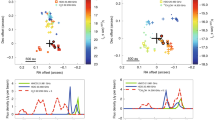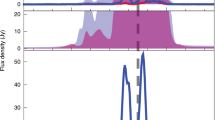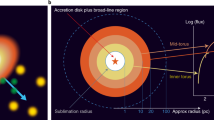Abstract
The 616–523 transition of water vapour at 22.235080 GHz has been found in our Galaxy to be associated with regions of young star formation1,2. H2O maser emission was detected initially in an external galaxy by Churchwell et al.3. To extend the range of detected properties of ‘star burst’ galaxies (galaxies showing an enhanced star formation from their optical spectra) we undertook an initial survey for H2O maser emission in this type of galaxy, but with negative results. Here we report on the subsequent extension of this survey to spiral galaxies displaying continuum radio emission, which is also an indication of star formation activity. We have detected the most luminous H2O maser source yet reported, ∼500 L0, in the galaxy NGC3079. OH absorption was also detected in this galaxy and we suggest that maser amplification of the nuclear radio source causes the observable H2O emission.
This is a preview of subscription content, access via your institution
Access options
Subscribe to this journal
Receive 51 print issues and online access
$199.00 per year
only $3.90 per issue
Buy this article
- Purchase on Springer Link
- Instant access to full article PDF
Prices may be subject to local taxes which are calculated during checkout
Similar content being viewed by others
References
Lo, K. Y., Burke, B. F. & Haschick, A. D. Astrophys. J. 202, 81 (1975).
Genzel, R. & Downes, D. Astr. Astrophys. Suppl. 30, 145–168 (1977).
Churchwell, E. et al. Astr. Astrophys. 54, 969 (1977).
Condon, J. J. Astrophys. J. Suppl. 53, 459–495 (1983).
Israel, F. P. & van der Hulst, J. M. Astr. J. 88, 1739–1748 (1983).
Nilson, P. Uppsala Astr. Obs. Anum. 6 (UGCG), 154 (1973).
Claussen, M. J., Heiligman, G. M. & Lo, K. Y. Nature 310, 298–300 (1984).
Dos Santos, P. M. & Lepine, J. R. D. Nature 278, 34–35 (1979).
Moorwood, A. F. M. & Glass, I. S. Astr. Astrophys. 135, 281–288 (1984).
Gardner, F. F. & Whiteoak, J. B. Mon. Not. R. astr. Soc. 201, 13P–15P (1982).
Baan, W. A., Wood, P. A. D. & Haschick, A. D. Astrophys. J. Lett. 260, L49–L52 (1982).
Baan, W. A. & Haschick, A. D. Astrophys. J. 279, 541–549 (1984).
Downes, D. in Birth and Infancy of Stars (eds Lucas, R. & Omont, A.) (in the press).
Strelnitzkij, V. S. Mon. Not. R. astr. Soc. 207, 339–354 (1984).
Whiteoak, J. B. & Gardner, F. F. Astrophys. J. 195, L81 (1974).
Author information
Authors and Affiliations
Rights and permissions
About this article
Cite this article
Haschick, A., Baan, W. A very bright water vapour maser source in the galaxy NGC3079. Nature 314, 144–146 (1985). https://doi.org/10.1038/314144a0
Received:
Accepted:
Issue Date:
DOI: https://doi.org/10.1038/314144a0
This article is cited by
-
H_2O Megamasers: Accretion Disks, Jet Interaction, Outflows or Massive Star Formation?
Astrophysics and Space Science (2005)
-
A water-vapour giga-maser in the active galaxy TXFS2226 – 184
Nature (1995)
-
Extremely-high-velocity H20 maser emission in the galaxy NGC4258
Nature (1993)
-
Dense molecular gas in galactic nuclei
The Astronomy and Astrophysics Review (1991)
Comments
By submitting a comment you agree to abide by our Terms and Community Guidelines. If you find something abusive or that does not comply with our terms or guidelines please flag it as inappropriate.



